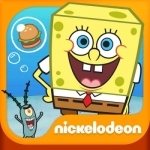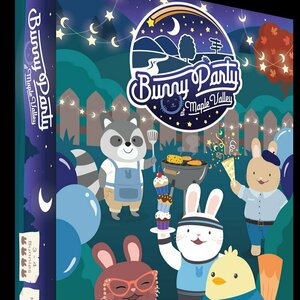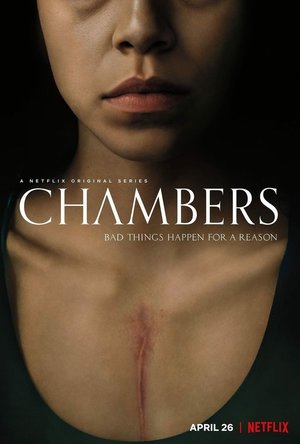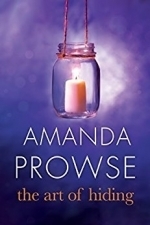Purple Phoenix Games (2266 KP) rated Bunny Party at Maple Valley in Tabletop Games
Oct 11, 2021
Bunny Party at Maple Valley (which I shall refer to as simply Bunny Party from here) is a sweet and cute little card game for three or four players. In it players are the titular bunnies decorating for and competing to win the chance to host the Night Sky Party at their place. However, in this game more often than not the victory is shared between they who amass the requisite five decorations and their neighbor who also co-hosts the event! The bunnies gotta get crackin’ so let’s get going!
PS – I will be reviewing the 3-player version of the game, which has ever-so-slightly different rules.
DISCLAIMER: We were provided a copy of this game for the purposes of this review. This is a retail copy of the game, so what you see in these photos is exactly what would be received in your box. I do not intend to cover every single rule included in the rulebook, but will describe the overall game flow and major rule set so that our readers may get a sense of how the game plays. For more in depth rules, you may purchase a copy online or from your FLGS. -T
To setup, character cards are shuffled and two dealt to each player. They choose one to be their avatar and discard the other back to the box. The large deck of cards with the house on the back is shuffled and placed on the table within reach. The villager cards are shuffled and one is drawn and placed outside the play area – it will not be used this round. The other five villagers are arranged as a market of friends. Each player draws three cards on the first round, and the game is ready to begin!
Bunny Party is played over a series of rounds until one player satisfies the win condition. Each round consists of eight phases: Turn Start, Tidy a Card, Villagers Visit, Play Cards, Trade, Play Cards (again), Party Start?, and Villagers Go Home. Turn Start typically involves players setting the table for the round. First, the villager cards are re-shuffled, one set aside to be ignored this round (they are staying home), and the remainders displayed. Then each player draws two cards from the deck and collects one Trade Token.
Next, all players will choose one of their cards they drew during the Tidy a Card step to be placed in a temporary discard pile face-down. Alternatively, a player may forego the Tidy in order to place a card in front of another player by spending one Trade Token. Once all players have tidied a card or placed one in front of another player, the Tidy pile is shuffled, then flipped as a stack to the top of the discard pile, face-up.
The villagers are now becoming impatient, so players will allow them audience during this Villagers Visit phase. Each player chooses a villager from those available to host during their party preparation. These villagers offer special abilities each round and can be very valuable at certain times during the game.
While the villagers are visiting, players may next Play Cards from their hand. These cards are typically of three types: Item, Event, or Decoration. Item cards are placed in the player’s tableau and offer one-time or lingering effects. Event cards are typically one-and-done cards to be completed and then discarded. Decorations are what players are really after, as they are what determine win conditions. With five star or moon cards the player can start the party and end the game. At the bottom of the decoration cards is printed an arrow. This arrow points to the neighbor that will co-host and also win the game. In a three-player game Decoration cards are displayed upside down, so that is why the photo below looks a little strange.
When players have all played their hand of cards, the Trade phase may begin. Players may offer Item cards to other players and a trade may be struck by each player discarding a Trade Token from their stash. This may result in a player receiving a new card to be played. When this happens, the next phase is immediately played (after all trades have been completed). Any player who now holds an unplayed card may Play Cards (again) as before.
If a player (or players) have now collected five or more star or moon Decoration cards, they may claim victory during this Party Start? phase. Again, the Decoration cards have arrows printed to determine the co-host/co-victor in the game, and the winners may then invite the rest of the burrow to their den for the Night Sky Party! However, if no victor emerges during the Party Start? phase, then all the Villagers Go Home, and a new round begins with the Turn Start phase.
Play continues in this fashion until winners have been crowned host and co-host of the Night Sky Party in Maple Valley!
Components. This one is a bunch of cards a few cardboard chits. The cards are all fine quality, as are the chits. What is really great about these components is the art on them. I cannot think of many cuter themes than uber-nice bunnies throwing a party and sharing their victory with a neighbor. So obviously the art has to match the theme, tone, and style of the game. I believe Bunny Party knocks it out of the park here. The art is so playful and cute, and I absolutely have to give a huge shout out to Evan’s Games for the very apparent inclusivity and representation. I see you and I applaud you!
Gameplay for me is where I take just a little issue. Everything works, and once you understand the phases it does flow better, but, I can see myself really only playing this with children or in a gateway/breaking in new gamers situation. It is very light, but there are eight phases to a round! So while each phase is easy to understand and execute, each round takes a little longer because there are a few too many steps. Once my kids really know how to read well they will be playing this with me and I know right now that we will have a great time with it. I really do appreciate the special efforts that were made with regards to representation (yes, even with anthropomorphic cartoon animals) and with the design being more focused on sharing victory and being nice to neighbors. My children will certain have good habits reinforced while playing this, and that is what makes this game important.
Again, this is not the game for hardcore gamers, nor those who are interested in bigger and more complex medium-weight games. This is a quick filler at best during a game night when newer gamers are gathered. That being said, I still find a great deal of value in this one, and will be keeping it for a long time. Purple Phoenix Games gives this one a 4 / 6 on stand-by. I do want to try this with different types of people (once we are able again) to see if my predictions are correct. I have only been able to play it with adult family, and none of them are medium to heavy weight game enthusiasts. If you are needing a nice game that can be played among other games for a themed game night (like Bunny Party + Bob Ross: Art of Chill + Hues and Cues + Escape: The Curse of the Temple) then this certainly fits that niche.
So my official stance, for now, is that Bunny Party has a great theme, excellent art, a wonderful message of harmony, but is both too light and too complex for what it is. I realize that sounds ridiculous. Please try it and let me know your thoughts. For now, I am keeping this close and I will be trying it with various groups with whom I game.

Bill & Hillary : So This Is That Thing Called Love
Darwin Porter and Danforth Prince
Book
On the campus of Yale University, in 1970, an "odd couple," Hillary Rodham and Bill ("Bubba")...
When I first put this on, I was just putting it on as background noise while I worked on art. But I ended up becoming drawn into the thriller and mysteriousness of the story.
Chambers begins with the MC, Sasha Yazzie telling her father, Frank, that she is going out to study. But in reality, she's going out with her boyfriend TJ Locklear - in the hopes that she will lose her virginity. The couple goes into a mattress shop to do the deed when Sasha's head starts pounding. She ends up passing out and rushed to the hospital.
Months later, we see the scar from a heart transplant. Sasha had a heart attack, which was very random and rare. She is miserable from missing a ton of school, having to be on anti-rejection pills for the rest of her life, and for everyone treating her like a porcelain doll.
One day, she walks into Frank's shop and meets Ben Lefevre who was the father of Becky, the teenage girl who gave Sasha her heart. Sasha is deeply creeped out when Ben asks for Frank and her to come to dinner. But when she goes to refuse, Frank agrees since he empathizes with the family.
When they arrive, Sasha is peppered with questions about her ambitions from Nancy, Becky's mother and snarky comments from Becky's brother, Elliot. The Lefevres tell Sasha that they are taking Becky's college fund and establishing a scholarship that they want her to have. Sasha soon sees a picture of Becky and eventually starts having visions, a major one happens during an Arizona dust storm that forces the Yazzies to stay at the Lefevres' house.
Sasha accepts the scholarship where she attends Becky's old school. This new school is very upper class, I mean it has "nap rooms" and "life coaches" and not all of Becky's old friends are reluctant to be friends. Sasha finds out via a few of Becky's old friends how exactly Becky died, but it doesn't make sense at all. The show continues on with a few twists and turns, a few trigger scenes, and was captivating.
Chambers is an odd yet enthralling show that also gives a foreboding tone. The creator doesn't hide some of the messages you see in the first episode, but it's all things we've seen done before. Like the Lefevres having it all while the Yazzies are a working-class family. The main reason why I kept watching until the very end was the mystery surrounding Becky's death and Rose's performance as Sasha. Throughout the episodes, you can see that Sasha doesn't go around "stopping and smelling the roses" all because she was given another chance to live. She resents the heart and just wants to be a normal teen again. Which is totally understandable. Getting an organ transplant is a hard thing to go through, especially at such a young age like under 17 years old.
If you're into thrilling mysteries that have a bit foreshadowing, I highly recommend Chambers. You can stream it on Netflix!

Nighty Night! - The bedtime story app for children
Book and Education
App
The most popular bedtime story on the App Store! Over 4 million downloads. „App of Year“...

Nighty Night! - The bedtime story app
Book and Education
App
The most popular bedtime story on the App Store! Over 4 million downloads. „App of Year“...
Purple Phoenix Games (2266 KP) rated Dragons Wild in Tabletop Games
Feb 1, 2021
Dragons Wild is a trick-taking game very similar to the old standard, Rummy. So like its predecessor players are trying to rid their hands of cards in order to signal the end of the game. Where this version separates is in the little details that are absent from Rummy.
DISCLAIMER: We were provided a prototype copy of this game for the purposes of this review. These are preview copy components, and I do not know for sure if the final components will be any different from these shown. Also, it is not my intention to detail every rule in the game, as there are just too many. You are invited to download the rulebook, back the game through the Kickstarter campaign launching February 2, 2021, or through any retailers stocking it after fulfillment. -T
To setup choose a dealer and a scorer (different players). The dealer will shuffle the entire deck of cards, save for the scoring cards, and deal each player seven cards. The draw deck is placed in the middle of the table and the dealer flips the top card to create the discard pile. The scorer finds the reference score card and places the dragon token on or near the “Round 1, Score 8 per card” text. The game may now begin!
Generally, the game is played much like Rummy where players are attempting to lay down melds of cards containing either runs (1, 2, 3, 4, etc) or sets (2, 2, 2 of different suits). Once a player has a meld in front of themselves they may play their cards onto other players’ melds. Players must discard a card at the end of each turn, and play continues in this manner until a player runs out of cards.
Dragons Wild, however, adds a few twists to pump up the play of traditional Rummy. Each player will need to keep track of their point totals as they will change with each play of a card. Should a player lay a meld on Round 1 they score eight VP for each card laid. In Round 2 cards are worth seven points each. Round 3 each card is worth six points and so on until Round 8 (or more) where each card is worth just one point.
Another way in which Dragons Wild differs from its older cousin is in the buying of cards (as far as I remember – I’m no Rummy expert). On their turn the active player must draw a card from either the top of the draw deck or the top of the discard pile. However, before the active player chooses, should another player wish to buy the face-up discard card the active player decides to allow or disallow the buy. With a successful buy the buying player takes the discarded card as well as the top card of the draw deck as payment. A player may buy as many as three cards in this fashion for each new active player.
Also, Dragons Wild offers a slight rule change for Wild cards in melds. Every time I have played Rummy in my lifetime any Wild is up for grabs as long as it can be replaced with a legal card from any player’s hand on their turn. This is not the case in Dragons Wild, as only Wild cards that hang on the end of a RUN of cards may be taken, replaced, or moved to the other end by the active player.
The game ends once one player is able to rid their entire hand of cards and still have one card to discard at the end of their turn. Players then total their scores from all cards played, scoring points differently depending on the Round in which they were laid. Other players still possessing cards then subtract the NUMBER of cards still held from their entire score, not their values. The player with the most points after this scoring phase is the winner!
Components. Again, this is a prototype copy of the game, and I am completely unsure which, if any, components will be upgraded as a result of a successful Kickstarter campaign. That said, I can comment on a couple things. First, the art style. While it is not my cup of tea (dragons have tea parties, right?) I can see where others may quite enjoy its fancifulness and whimsy. The game is very colorful, and I do appreciate that quite a lot. The cards are laid out well, and each suit is a different species of fantastic beast (though I rarely knew which was which – I just paid attention to the background color in the corners of the cards mostly). So I have no real problems with the components at all, I just wish for different art. The designer was nice enough to send along a print of a purple phoenix with this copy, which is super rad of her, and it looks great. Maybe she will add them into the final version…
Gameplay is familiar, like I stated earlier, because I would think most people have played Rummy or a variation of it at some point. In fact, my family was big into Rummikub growing up, and my grandparents were big into Rummy proper. So this was somewhat nostalgic for me while also bringing a few house rules and art that is different from a boring deck of normal playing cards.
The rules are not at all difficult, so learning, teaching, and playing have not seemed to be an issue at all here. If players have all played a version of Rummy before then this one will fly pretty quickly. It is a simple, fast, and slightly unique version of Rummy that would be nice to keep around if you need to wait on another player to arrive and they are 10 minutes away, or as a palette cleanser between games. Definitely a filler game, and not at all a bad one!
If you are looking for a differently-themed Rummy replacement with a twist, I recommend checking out Dragons Wild. It’s cute, quick, and has dragons, for Pete’s sake. Consider backing the Kickstarter campaign or asking your LFGS to stock it upon release.
Sassy Brit (97 KP) rated The Art of Hiding in Books
Jun 5, 2019
Nina has it all, great house, loving husband, and two well-looked after kids who could literally have anything they wanted should they ask. But after tragedy strikes, and her husband Finn is killed in car accident, suddenly Nina is left with a mountain of debt and two ‘posh’ kids who do not know how to cope in the real world when everything they know is drastically all taken away from them.
I loved the fact that her husband was maybe not the good guy in all this either, I mean, how could he amount so much debt and not tell his own wife? What was he thinking? Yes, that’s right, he wasn’t! This also means that because of his past actions she now has to stick up for her husband when talking about him to her kids for their sake. He was their dad, after all. Difficult, though. Especially when deep down she’s angry about the secrets he’s been keeping from her when he was alive, and the impact it’s going to have on them all now he’s gone and left them with a mess to cope with.
What’s worse is there is absolutely nothing she can do to change that now. Life has to go on, and deal with this situation they must. If only he had talked to her they wouldn’t have been in this mess, but in all honesty, no one could foresee the accident. Isn’t that always the way? Makes you think, doesn’t it? Life can be taken away from you just like that *snaps fingers*.
I enjoyed seeing Nina’s character grow from strength to strength. Not only was she forced to turn her own life around and face the harsh reality of what her husband had done, she also had to help her kids through their struggles of losing their dad, their home, their school, friends, and everything they ever thought was their life, as they knew it. I can’t imagine living such an affluent life only to have it all taken away like that, but I can imagine it to be a realistic issue that could happen to someone very easily. This is exactly why I enjoyed this book immensely. The emotional depth and self discovery that Nina and her kids went through was a treat to read! (Oh, that sounds rather sadistic of me!) In fact, It was so good I even shed a tear. You know, the sad but happy, mixed feelings kind?
In a way this is not the physiological thriller I expected, but more of a family drama.
If you haven’t got your hands on this compelling book yet, don’t delay any longer! If it SOUNDS like something you’d like, it will most likely BE something you’d LOVE! Amanda Prowse knows how to tell a realistic story that tugs on your heartstrings, and really makes you think. A well written story of love, lies and one’s determination to do whatever it takes to protect her family during a time of crisis and disarray.
Thank you to the author, and Netgalley for my copy in exchange for my unbiased opinion. Actually, I also won this paperback version in a Goodreads contest.

Yodha Love Astrology Horoscope Vs Daily Horoscopes
Lifestyle and Reference
App
Why settle for an ordinary horoscope when you can have access to authentic Vedic astrologers from...
Hadley (567 KP) rated Ghostly Tales: Spine-Chilling Stories of the Victorian Age in Books
Jan 20, 2021
Since this is a short story collection, I will list the stories with a short synopsis and what I liked and disliked about them.
"Oh, Whistle, and I'll Come to You, My Lad" by M.R. James
A professor decides to go on vacation to work on his golf game while doing a little side work in the town's archaeology, but when he digs up an old whistle and blows into it, he instantly regrets what the whistle brings.
Liked: the buildup to the climax was done masterfully, and the superstition that was used as the premise of the story
Disliked: that the ending is never explained
"The Old Nurse's Story" by Elizabeth Gaskell
When a governess and her ward are taken to a haunted house, they found out that everyone has to pay for their misdeeds.
Liked: the perfect example of what Victorian ghost stories were
Disliked: Nothing; I really enjoyed this one
"The Signalman" by Charles Dickens
A railroad signalman tells a co-worker that he is seeing a ghost that warns him of future accidents, but his co-worker can't tell if he's telling the truth or losing his mind.
Liked: an excellent ghost story; I wish it were an entire novel
Disliked: nothing
"The Body-Snatcher" by Robert Louis Stevenson
When a medical student realizes that the 'donated' bodies are murder victims, he's not so sure he can live with the consequences.
Liked: the ending wasn't predictable
Disliked: at the start, there's a little confusion among who is who
" The Captain of the Pole-Star" by Sir Arthur Conan Doyle
A group of whalers are stuck in the middle of the ocean because of ice burgs, but the ice is the least of their problems when they begin to hear and see supernatural things out on the ice.
Liked: the plot of the story was really good
Disliked: the run-on sentences, some of the accents were hard to decipher, and the ending wasn't explained
"The Phantom Coach" by Amelia B. Edwards
A young man loses his way while on a hunt, but soon finds help with an old man that is convinced the supernatural is real, and when he senses the young man does not, he puts him up against forces from the other side.
Liked: the story never lulled, and the descriptions of the undead were amazing
Disliked: nothing, I thought the story was really good
"The Screaming Skull" by F. Marion Crawford
When the friend of a family finds a skull in the latter's home, he begins to question whether or not the husband murdered his wife.
Liked: I love that this story is actually based off an urban legend
Disliked: the way the author kept breaking away from the story to talk to the audience; it caused the flow of the story to stop
Overall, the Victorian-era authors knew how to write a ghost story. I absolutely loved this collection of short stories. I highly recommend this book to people who love a good 'ol fashioned ghost story (not the gory ones we have today).

SpongeBob Moves In
Games and Entertainment
App
Ranked #1 App in 44 countries! Dive into Day 1 of SpongeBob’s life in Bikini Bottom! Move him into...




